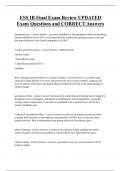ESS IB Final Exam Review UPDATED
Exam Questions and CORRECT Answers
greenhouse gas - Correct Answer- a gas that contributes to the greenhouse effect by absorbing
infrared radiation such as CFC's and carbon dioxide (unlike non greenhouse gases) Any gas
that traps radiation in the Earth's atmosphere is a GHG.
5 major greenhouse gases - Correct Answer- -carbon dioxide
-nitrous oxides
-Tropospheric ozone
-Chlorofluorocarbons (CFCs)
-methane
IPCC (Intergovernmental Panel on Climate Change) - Correct Answer- a scientific body
under the United Nations. It reviews and assesses the most recent scientific, technical and
socio-economic information and data produced worldwide relevant to the understanding of
climate change
greenhouse effect - Correct Answer- the process by which the sun's thermal heat is trapped in
the planet's lower atmosphere, distributed in all directions, and consequently causing the
average surface temperature to rise (this is considered to be a good process, but not in a
positive feedback way)
"enhanced" greenhouse effect - Correct Answer- increase in the natural greenhouse effect
resulting from increases in atmospheric concentrations of GHGs due to emissions from
human activities, Rise in temperature from human effects of Greenhouse gases
global dimming - Correct Answer- a decline in the amount of light reaching the earth's
surface because of increased air pollution, which reflects more light back into space
carbon trading - Correct Answer- a factory can produce only one certain amount of CO2
(carbon credits)
,carbon taxes - Correct Answer- if factories, other industries, etc. pollute they will pay money
for the amount of pollution
Kyoto Protocol - Correct Answer- controlling global warming by setting greenhouse gas
emissions targets for developed countries, nations who signed had to cut C emissions by 5%
then raised to 12.5% USA and Saudi Arabia didn't sign, in 2005, these rates were legal,
signed in 1997, exempted China
effects of global dimming - Correct Answer- -leads to slower evaporation rates
-causes reduction in amount of precipitation (resulting in drought and famine)
-alteration of world's rain belt
-counteracts effects of global warming
point source pollution - Correct Answer- comes from an easily identifiable source, for
example visible car exhaust fumes, and is considered more manageable (because the source
of the pollution can be directly identified it is easier to stop the pollutant), more localized,
easier to legal action. Ex: Factories, Power plants, etc.
non-point source pollution - Correct Answer- comes from a more diffuse source, not easily
identified, not well managed( ex. pollution is runoff from fields)(because the source of the
pollution is harder to identify, it takes more resources to find the source and stop its spread)
4 major pollutant sources - Correct Answer- fossil fuels
domestic waste
industrial waste
agricultural waste
domestic waste - Correct Answer- food waste, sewage, rubbish (glass, plastics, paper, wood,
metals), extremely hard to get rid of because isn't recycled, part of solid waste
industrial waste - Correct Answer- heavy metals, heat (in air and/or water), acids, part of solid
waste
agricultural waste - Correct Answer- fertilizers, animal waste, and pesticides contaminate
water sources, part of solid waste
, BOD (biological oxygen demand) - Correct Answer- the amount of dissolved oxygen needed
by anaerobic organisms in a body of water to break down organic material present in a given
water sample (high BOD low OD)
reduce - Correct Answer- involves altering and decreasing pollution through education and
incentives (includes using technology and reusing and recycling)
regulate - Correct Answer- involves setting imposed standards and introducing measures for
getting rid of pollutants from waste
restore - Correct Answer- involves restoring ecosystems through extracting pollutants from
the environment and restocking and replanting animal populations (costs a lot of money and
isn't always a long term solution).
stratospheric ozone - Correct Answer- good ozone, produces oxygen molecules to interact
with UV radiation and prevent 95% of it from reaching the surface
acid deposition - Correct Answer- Sulfur oxides and nitrogen oxides, emitted by burning
fossil fuels, enter the atmosphere- where they mix with oxygen and water to form sulfuric
acid and nitric acid- and return to Earth's surface.
solid domestic waste - Correct Answer- waste produced by people living in their homes (as
opposed to other sources of waster such as agriculture, industry, and the service sector)
photochemical smog - Correct Answer- brownish haze that is a mixture of ozone and other
chemicals, formed when pollutants react with each other in the presence of sunlight
DDT - Correct Answer- pesticide used for mosquitoes which bioaccumulates and was banned
in the US in 1972
Indirect method for pollution measurement (water) - Correct Answer- -Biological Oxygen
Demand
-Macrobenthic invertebrates: There are bacteria that only lives in polluted water, and others
that only live in clean water - "Trent Biotic Index"





